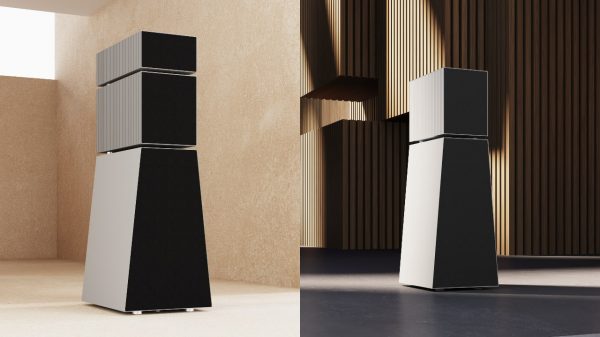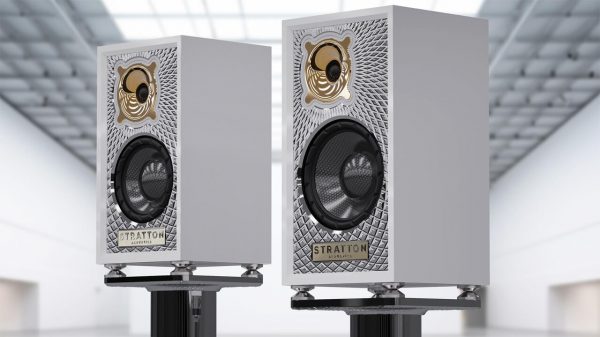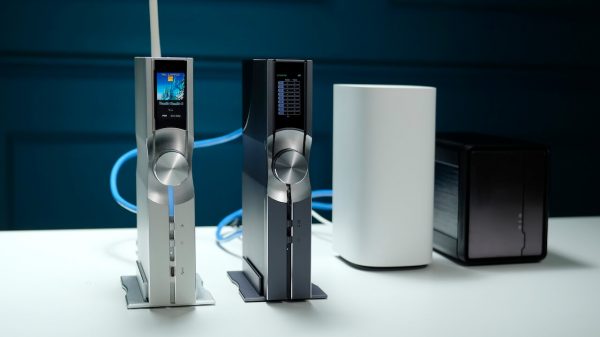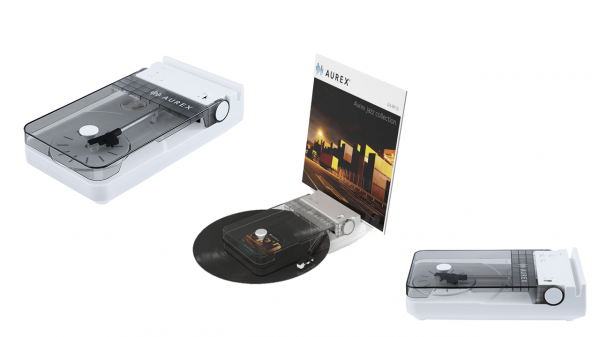Audiolab announced two CD players, the 8200CD and 8200CDQ. The new players are the first products to emerge from Audiolab's latest generation of audio components, the 8200 Series, sporting clean-sheet circuit design and supplying a unique array of facilities and connectivity options, including high-definition USB ports.
The 8200CD is priced at £699.95 and includes the following highlights:
- Exceptional connectivity, including a USB port and XLR outputs
- USB port can be used to enhance the quality of digital audio playback from a PC, Mac etc.
- Any PC/Mac media player (iTunes etc.) can be controlled via the Audiolab's remote handset
- USB port also allows the player to be upgraded via firmware updates in the future
- Four selectable digital filters enable the user to tailor the sound to his/her own taste
- Ultra-high-quality 32-bit DAC from ESS Technology
- Proprietary, discrete master clock ensures ultra-low jitter
- Balanced, discrete, Class A output stages maximise sound quality
The 8200CDQ is priced at £899.95 and sports the same specifications as the 8200CD with the addition of a complete digital/analogue preamplifier, all in an identically sized chassis.

While most CD players are designed purely for CD playback, the 8200CD and 8200CDQ have been created with flexibility firmly in mind. Their architecture is perhaps best described as a DAC + CD rather than as a CD player in the traditional sense. The DAC (Digital-to-Analogue Converter) is the cornerstone of their design, which is why Audiolab has chosen the Sabre 32-bit audio DAC from ESS Technology to carry out D-to-A conversion.
This DAC solution is rarely used in CD players because it is much more expensive than other audio DACs, and players that incorporate it usually cost many thousands of pounds. However, Audiolab believes that this is the best sounding DAC currently available, so rather than reverting to the cheaper modules found in most CD players, the ESS Sabre is embedded at the heart of the 8200CD and 8200CDQ.
The provision of digital inputs — optical, coaxial and USB — means the 8200CD and 8200CDQ can be used to deliver top-quality sound from all kinds of digital sources, including audio files from computers and other media devices. Thus, all music benefits from the superb sound quality produced by the players' DAC and discrete Class A output stages.
While most USB connections only support data up to 16-bit/48kHz, the 8200CD and 8200CDQ accept data right up to 24-bit/96kHz via USB, with bit depth and sampling frequency shown in real time on the player's LCD display. In addition, the USB link is asynchronous — this means data is regulated by the master clock in the player, rather than by the computer at the source, thus helping to minimise jitter (digital distortion).
The user can control the media player on his/her PC or Mac via the Audiolab remote, with the control signal transferred back to the computer via the USB port. This facility is driverless (in other words, it is built into the operating system) and is compatible with all media players — Apple iTunes, Windows Media Player etc.

Both the 8200CD and 8200CDQ incorporate a clock-locked CD transport, delivering excellent CD sound quality. All digital music, whether from CD or an external source, benefits from four selectable filter settings:
- Slow Roll-Off (delivers a smoother style of sound)
- Fast Roll-Off (delivers a crisper style of sound)
- Optimal Spectrum (delivers a flat response and optimal lab measurements)
- Optimal Transient (enhances transient response, thus promoting sonic pace and flow)
Users may switch between these settings via the remote, thus tailoring the sound according to taste. In blind listening trials conducted during development, the Optimal Transient setting proved most popular, closely followed by Optimal Spectrum. Users may decide to stick to their favourite filter setting or, if they wish, switch between the various settings to suit different music and recording styles. New filter upgrades will be made available for users to download and install via USB in the future.
The 8200CD and 8200CDQ enjoy extremely low levels of jitter thanks to the DAC's unique coupling with Audiolab's proprietary, discrete master clock, to the benefit of all forms of digital audio. Once converted to analogue, music signals are passed through a balanced, discrete, Class A FET output stage and on to the user's amplifier via either single-ended RCA or fully balanced XLR outputs. Four-layer PCB (Printed Circuit Board) construction and 34 regulated power supplies help to maintain optimal signal quality throughout.
In addition to the above, the 8200CDQ adds full preamp functionality whilst maintaining the same chassis size as the 8200CD. The existing digital inputs are joined by three line-level analogue inputs, providing source selection and volume control in the analogue domain. The preamplifier section is fully balanced and all analogue input signals are converted to balanced form, helping to reduce distortion and noise. Class A gain structures are present throughout, and users may choose between preamplification in the analogue or digital domain in respect of the digital inputs. In addition, the 8200CDQ adds a direct-coupled, discrete, Class A headphone amplifier, accessible via a socket on the front panel.
John Westlake leads the design team responsible for developing the 8200CD and 8200CDQ. John's technical skills have delivered award-winning digital audio products spanning the last two decades and a variety of companies have benefitted from his expertise, from Cambridge Audio and Pink Triangle to Logitech and Bose. His research is also utilised by a number of market leading electronic component manufacturers, including Zetex Semiconductors and Wolfson Microelectronics.
John is convinced that the 8200CD and 8200CDQ are the finest CD players he has ever designed and Peter Comeau, Director of Acoustic Design for IAG (Audiolab's parent company), agrees. “After many years of seeking a CD player that can bring me the level of musical emotion inspired by great performances on vinyl, I feel I've finally discovered, in the Audiolab 8200CD, a player that can do full justice to the music I have in my CD collection,” says Peter. “At last I can forget the source and just listen to the music.”
Price and Availability
- Audiolab 8200CD (£699.95) available from late August
- Audiolab 8200CDQ (£899.95) arriving in September
Both models are solidly built with all-aluminium casework and are available in a choice of silver (natural aluminium) or classic Audiolab black. The 8200CD and 8200CDQ are the first of a new generation of Audiolab products. A range of amplifiers is set to follow, forming the backbone of the all-new Audiolab 8200 Series.
Audiolab 8200CD and 8200CDQ – Key Features and Specifications
- 32-bit/84.672MHz oversampled/upsampled, 512 element, multibit array DAC (four DACs per channel)
- 1920x oversampling with 44.1kHz source from CD/USB
- Asychronous USB supporting 24-bit/96kHz with driverless remote control of PC/Mac media player (via HID support)
- 2x 24-bit/192kHz coaxial S/PDIF digital inputs
- 2x 96kHz optical digital inputs
- 3x 2Vrms analogue line-level inputs (CDQ only)
- Low jitter optical and coxial S/PDIF outputs
- Selectable analogue or digital preamplifier mode (CDQ only)
- High-current, single-ended and balanced, discreet Class A output stage
- High-performance, direct-coupled, discrete Class A headphone amplifier (CDQ only)
- Custom CD servo design — with ultra-low-noise PSU for OPU
- Full remote control and external remote I/O loop
- 34 regulated power supply rails
- 14 ultra-low-noise discrete regulators
- User-selectable digital filter settings — software upggradeable via USB port
- Output level @1kHz (standard setting): RCA 2.05Vrms ±0.1; XLR 4.1Vrms ±0.1
- Frequency response, ref. 1kHz, 20Hz-20kHz BW: RCA ±0.2dB; XLR ±0.2dB
- THD 1kHz, 0dB, 20Hz-20kHz BW: RCA <0.0025%; XLR <0.0008%
- Crosstalk 1kHz: RCA >120dB; XLR >130dB
- Dynamic range Awtd: RCA >98dB; XLR >110dB
- Master clock jitter less than 3psec short term
- Top-quality component parts used throughout, including: ultra-low-ESR capacitors; high-tolerance polypropylene film/foil capacitors; ultra-stable, very-low-VCR 0.1% MELF SMD resisitors; four-layer PCB
About Audiolab In 2010, Audiolab offers a tightly focused range of hi-fi and home cinema components, all drawing upon the company's original concept of simple, well-constructed ergonomics and crisp, transparent sound. This autumn sees the launch of a new generation of Audiolab products, the 8200 Series, where innovative design delivers class-leading sound and progressive product features. Thus begins an exciting new chapter in the life of this much-admired brand.
Formed in the early 1980s by Philip Swift and Derek Scotland, Audiolab earned worldwide acclaim with the 8000A — an integrated stereo amplifier that became a classic step-up from the budget models of the time. During the ensuing years, the 8000A established itself as one of the most successful British amps ever produced, and was joined by a range of electronics including CD players, pre/power amps and an FM tuner. The brand switched hands in 1997, changing its name to TAG McLaren Audio; and so it was known until 2004, when Audiolab became part of the International Audio Group and returned to its original name.
























